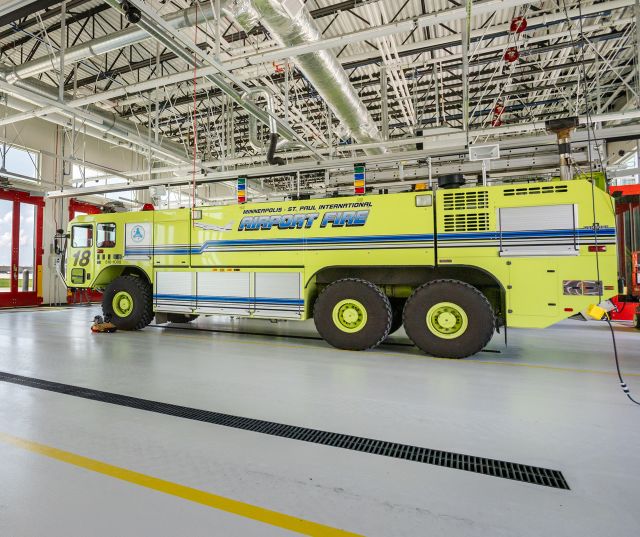New fire station highlights public safety investments at MSP Airport

Another project will create future high-tech public safety and operations center
The Metropolitan Airports Commission (MAC) opened a new aircraft rescue and firefighting (ARFF) station at Minneapolis-St. Paul International Airport (MSP), the first stage in consolidating public safety and airport operations into a high-tech facility for more advanced airport operations and emergency response.
The MAC celebrated the opening of the new $42.3 million, 25,000-square-foot Fire Station 2 with a ceremonial fire hose decoupling ceremony followed by a pull-through of ARFF crash trucks in the apparatus bay with fast-opening, red bifold doors. The station is approximately 50% larger than the previous station it replaced earlier this month, which was built in 1965.
“We’ve made quite the leap in facility design, systems and equipment to enhance the critical life safety work our firefighters do every day,” said Brian Ryks, CEO of the MAC, which owns and operates MSP. “This is a major step in our efforts to maintain the highest public safety standards as we serve our passengers, airlines and other stakeholders in the community.”
Fire Station 2 is located on the north end of the airfield adjacent to the MSP air traffic control tower. The MSP Airport Fire Department also operates Fire Station 1, which opened in 2005, on the south side of the airfield. MSP firefighters respond to approximately 3,200 calls a year consisting of medical cases, structural and aircraft emergencies, and hazardous materials calls. The fire department covers MSP’s 3,400-acre campus and has mutual aid agreements with nearby communities to respond to emergencies beyond the airport.
“The true focus in this new facility is a design based on the safety, health and welfare of our firefighters to support our 24/7 mission to protect and serve passengers and the public,” said MSP Fire Chief Mark Watczak. “There’s a clear separation of living quarters and the apparatus bay, which offers more protection and comfort for firefighters.”
For each firefighter that spends an average of 121 nights a year at MSP, the station offers major upgrades in comfort and privacy. This includes individual bunk rooms, locker rooms, a larger kitchen, and interactive meeting spaces.
The station is the first phase of a broader project to accelerate emergency response and optimize operations by uniting airport operations and emergency services under one roof. Construction began this summer on MSP’s next phase, a future Public Safety and Operations Center, which will connect to the new fire station.
“Safety encompasses every aspect of airport operations; it is the backbone of how we fulfill our mission of providing exceptional airport experiences so Minnesota thrives,” said MAC Chair Rick King. “The next phase highlights a long-term strategic initiative to optimize operations and increase performance in an integrated high-tech facility.”
The 158,000-square-foot Public Safety and Operations Center is designed for future co-location of the MSP Airport Police Department, Emergency Communications Center (a 911 public safety answering point), Airside Operations and other teams. These teams now operate across multiple locations on the airport campus. The full project is expected to be completed in 2027.
The unified airport teams will have technology and systems for improved awareness of day-to-day airport activities or emergency events and can collaborate more effectively in a new emergency operations center for strategic response and communications.
The MAC is pursuing LEED certification for the two-phased project. The high-performance structures incorporate improved insulation, energy efficient mechanical systems, and low impact materials and finishes. The buildings will utilize a water reclamation system, capturing rainwater for use in non-potable conditions (flushing toilets and urinals), providing an estimated 53% reduction in potable water use. Sustainable landscaping is also part of the overall design, using native plantings and fescue grasses that will not require watering, once established.